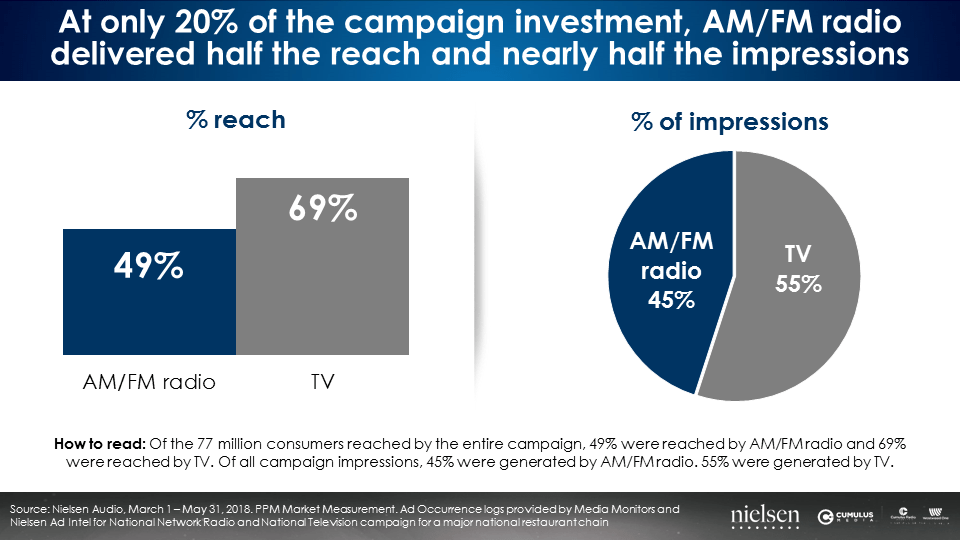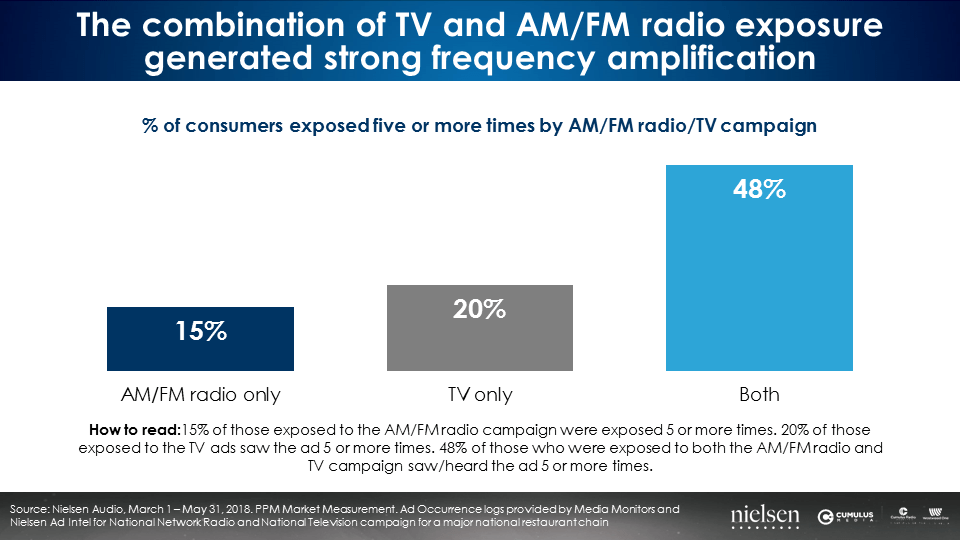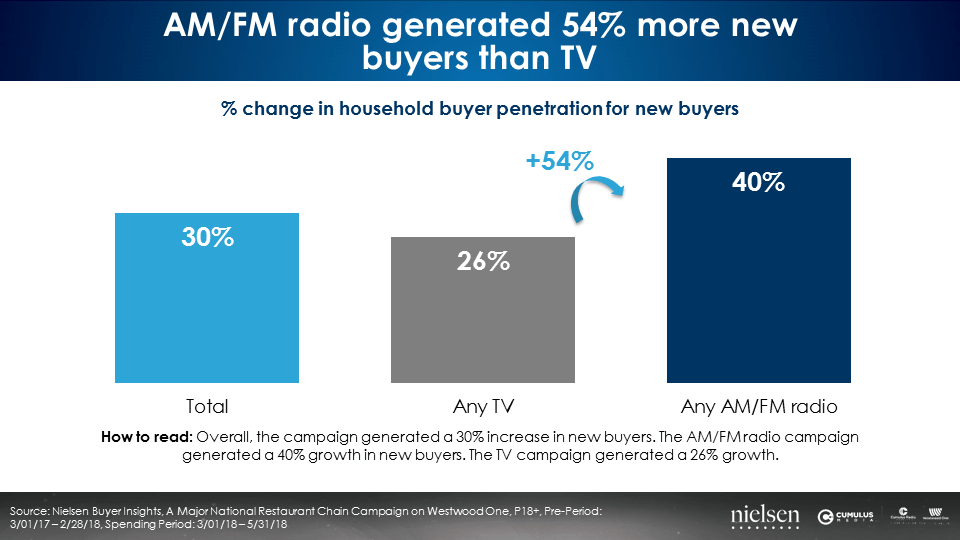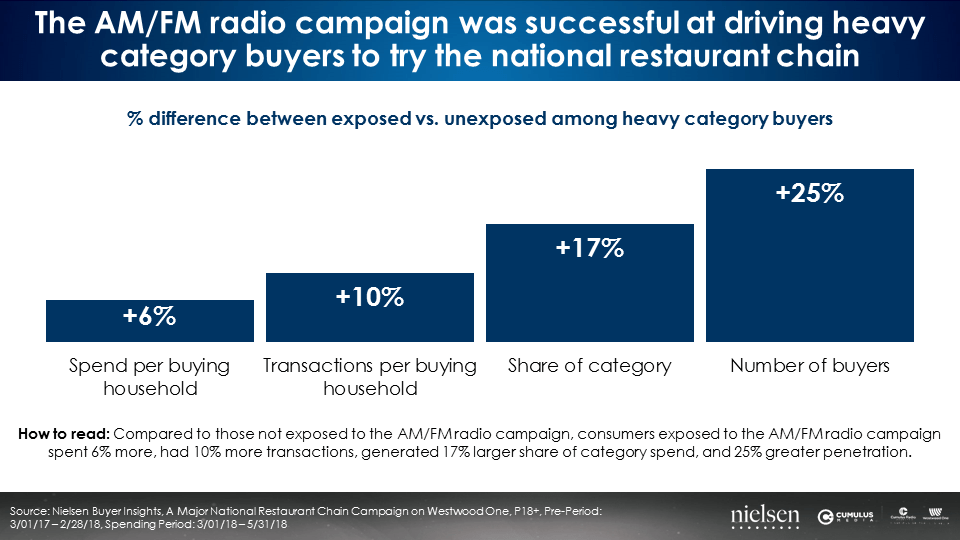Historic First-Ever AM/FM Radio And TV ROI Study Shows Supersized Sales Impact For National Restaurant Chain
AM/FM radio is an ideal advertising medium for quick service restaurants (QSR). Not only does the profile of frequent quick service restaurant visitors align closely with the heavy AM/FM radio listener, but the visitation patterns of QSR establishments also mirror AM/FM radio’s strong daytime listening spikes.
Want more evidence that AM/FM radio and QSR are a match? Nielsen studies from 2014 revealed AM/FM radio advertising increased total buyers, spend per buyer, and most importantly delivered $3 of incremental sales for every $1 spent.
Now, for the first time, Nielsen has conducted a television and AM/FM radio ROI study centered on QSR. While Nielsen has conducted dozens of sales lift studies for AM/FM radio campaigns, this is the first time the sales lift of AM/FM radio and TV were examined in the same study.
Commissioned by CUMULUS MEDIA | Westwood One, Nielsen matched Portable People Meter panel data with purchase data to reveal how TV and AM/FM radio impacted QSR sales for a major national restaurant chain. Nielsen conducted a spend analysis of the campaign that ran from March 1, 2018 through May 31, 2018, comparing those who were exposed and unexposed to determine ad effectiveness. Here’s what they found:
With only 20% of the campaign budget, AM/FM radio delivered nearly the same reach and impressions as TV
Though the major national restaurant chain spent only 20% of their campaign investment in AM/FM radio, the impact was significant. Of the 77 million consumers reached by the entire campaign, nearly half (49%) of them were reached by AM/FM radio.
Of all of the campaign impressions, AM/FM radio delivered 45%, nearly half of the total campaign impressions.

Despite light spend levels, AM/FM radio delivered extraordinary impact. AM/FM radio was also more cost-efficient than TV, delivering a cost per thousand impressions (CPM) that was 33% of TV. AM/FM radio’s cost per thousand net reach was also lower, only 38% of TV’s.
AM/FM radio boosted TV’s impact, adding incremental reach and amplifying campaign frequency
23 million consumers were reached by the AM/FM radio campaign but did not see the TV ad, adding 43% incremental reach to the total campaign.
Of the 15 million people reached by both TV and AM/FM radio, the frequency of the major national restaurant chain’s messaging was amplified. 15% of those exposed to the AM/FM radio campaign heard the ad 5+ times. Of those exposed only to the TV campaign, 20% saw the ad 5+ times. Exposure to both the AM/FM radio campaign and TV campaign together resulted in a jump to 48% of those who saw or heard the ad 5+ times.

AM/FM radio exposure generated more new buyers than television
One of the primary sales effects of the campaign was new customer generation. New buyer penetration grew 30% overall. AM/FM radio’s exposure grew buyers 40%, +54% higher than TV’s 26% impact.

The AM/FM radio campaign drove heavy category buyers to try the national restaurant chain
Among heavy category buyers, exposure to AM/FM radio ads drove significant action across key advertising metrics. Spend per buying household was +6% greater among heavy category buyers who were exposed to AM/FM radio than those who were unexposed.
There were more transactions, +10%, among heavy category buyers exposed to AM/FM radio than those unexposed. Share of category saw a +17% increase. Most significantly, penetration of heavy category buyers was up +25% compared to those unexposed to the AM/FM radio campaign.

To boost sales, just add AM/FM radio
AM/FM radio and quick service restaurants make a good team as exposure to AM/FM radio ads boosts sales growth and brings new buyers to the table. AM/FM radio also adds incremental reach and amplified frequency to TV campaigns at a more cost-effective rate for advertisers looking to make a major impact. In short, AM/FM radio makes your TV better.
Key takeaways:
- With only 20% of the campaign budget, AM/FM radio delivered nearly the same reach and impressions as TV
- AM/FM radio boosted TV’s impact, adding incremental reach and amplifying campaign frequency
- AM/FM radio exposure generated more new buyers than television
- The AM/FM radio campaign drove heavy category buyers to try the national restaurant chain
- To boost sales, just add AM/FM radio
Pierre Bouvard is Chief Insights Officer at Cumulus | Westwood One.
Contact the Insights team at CorpMarketing@westwoodone.com.